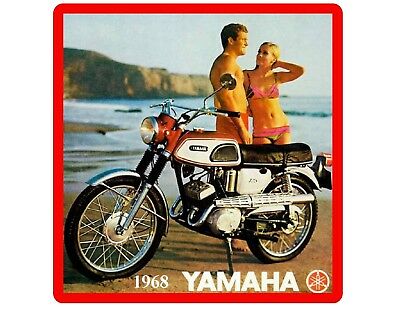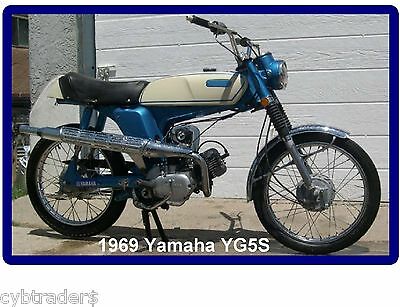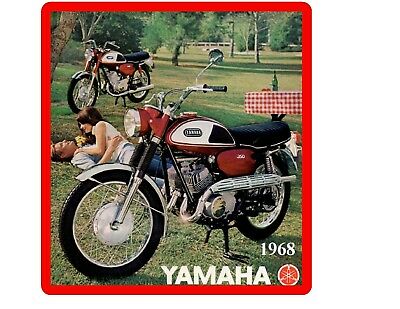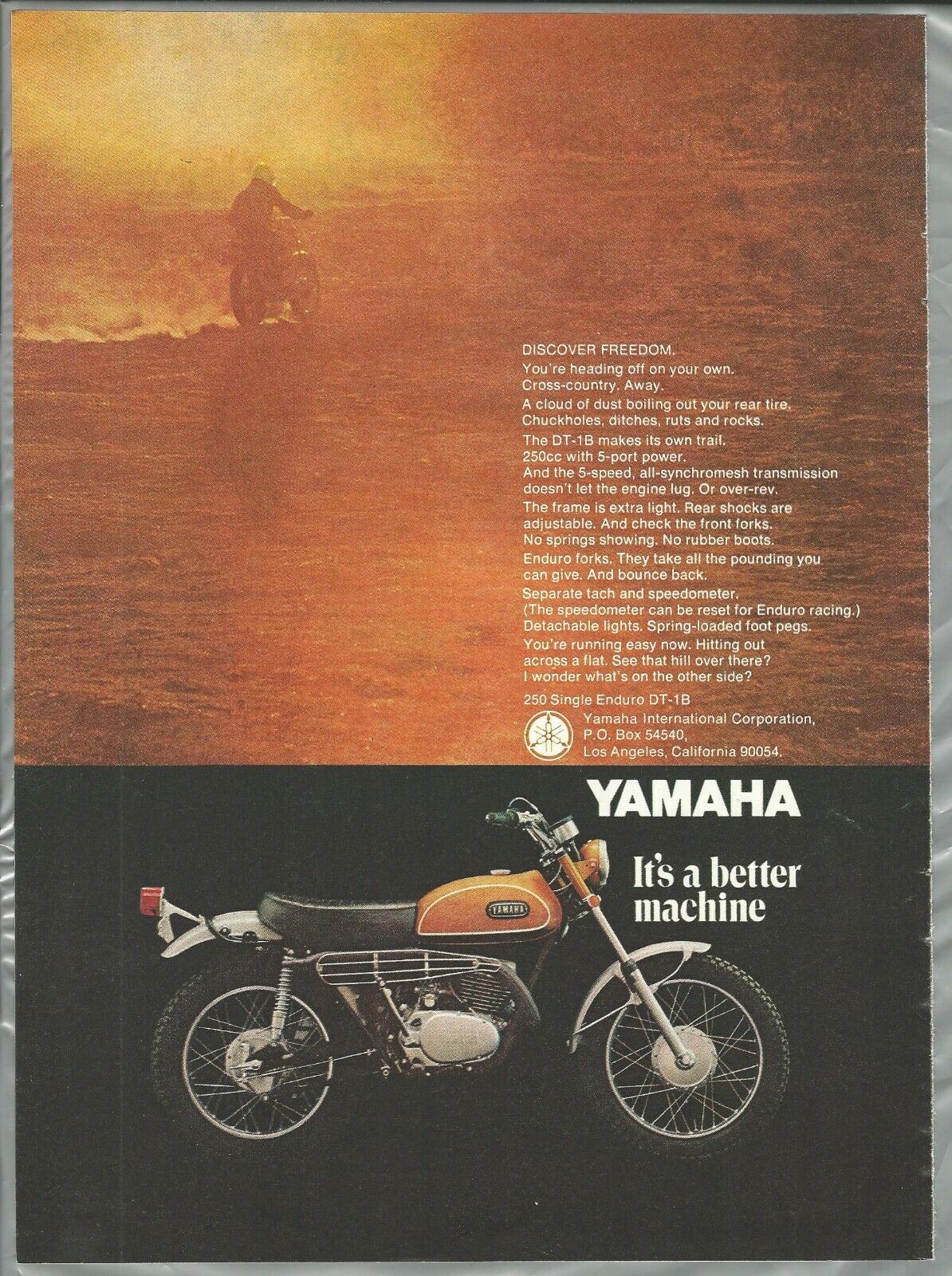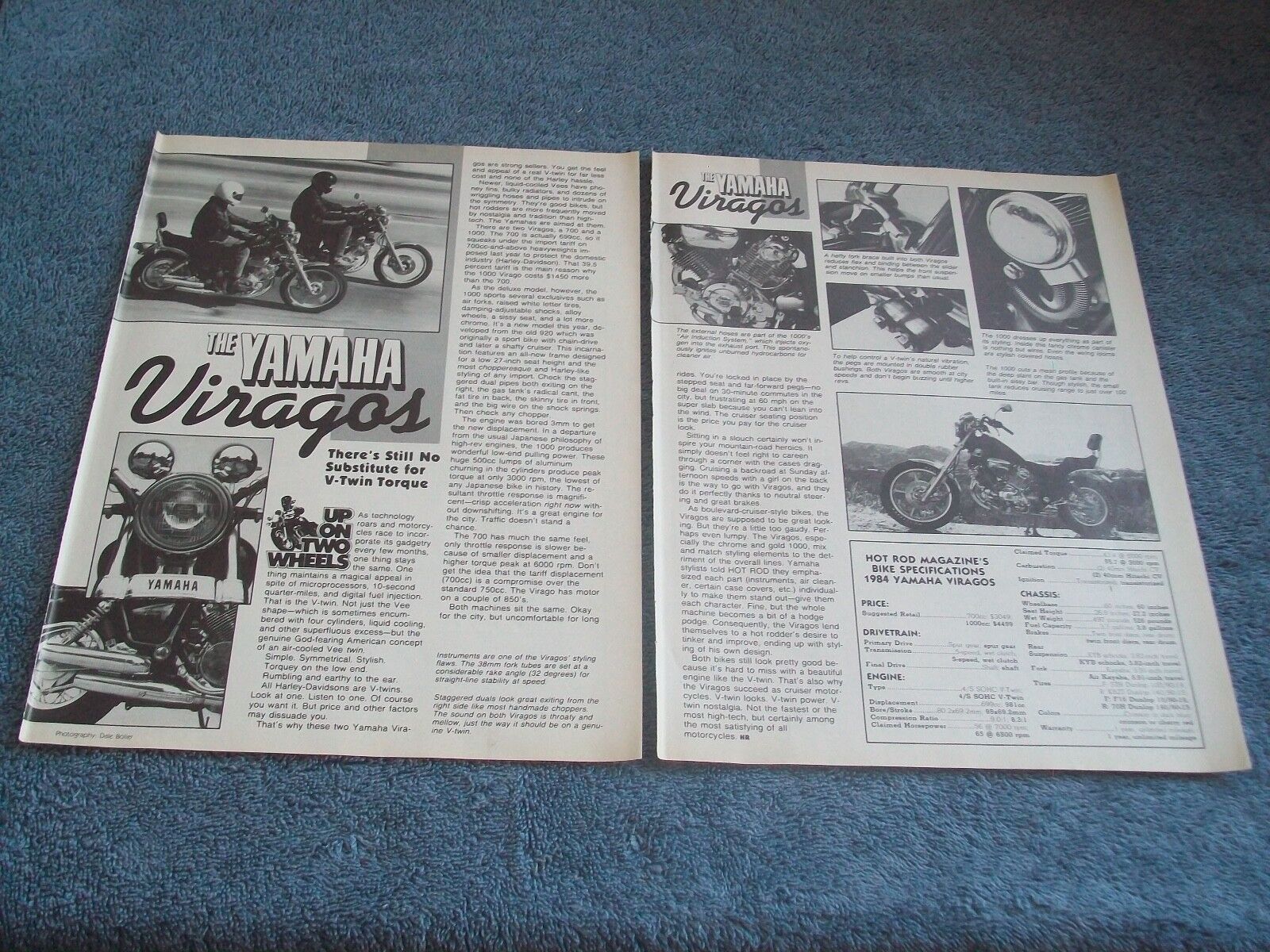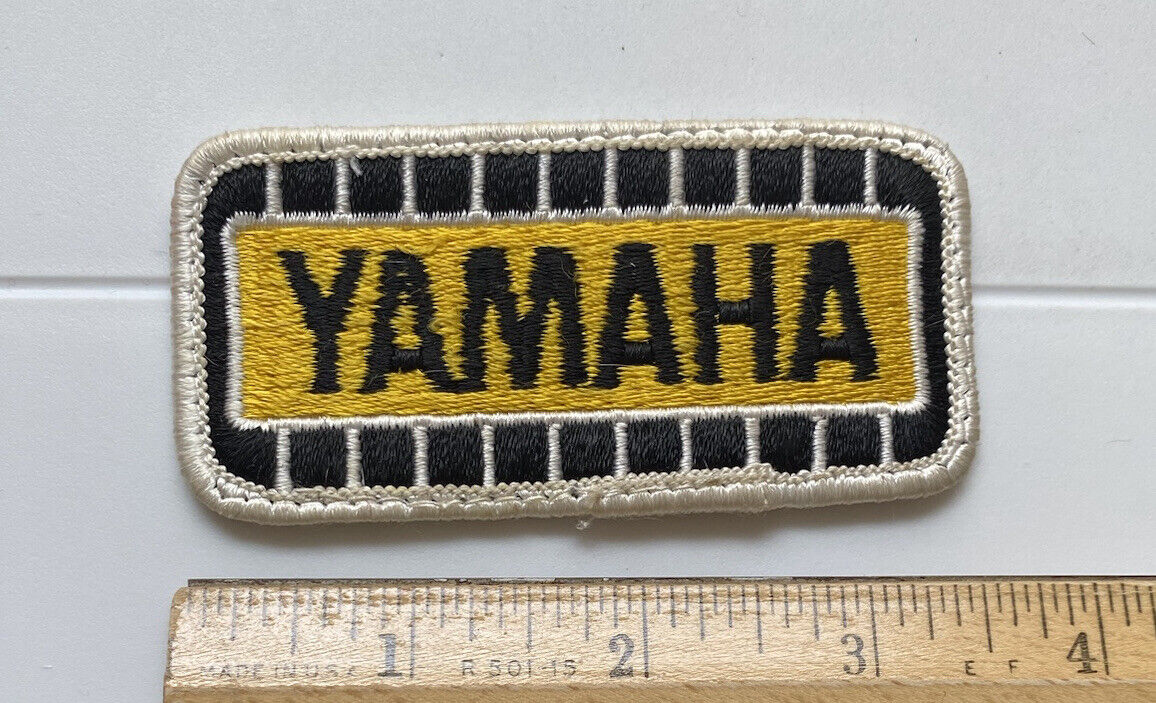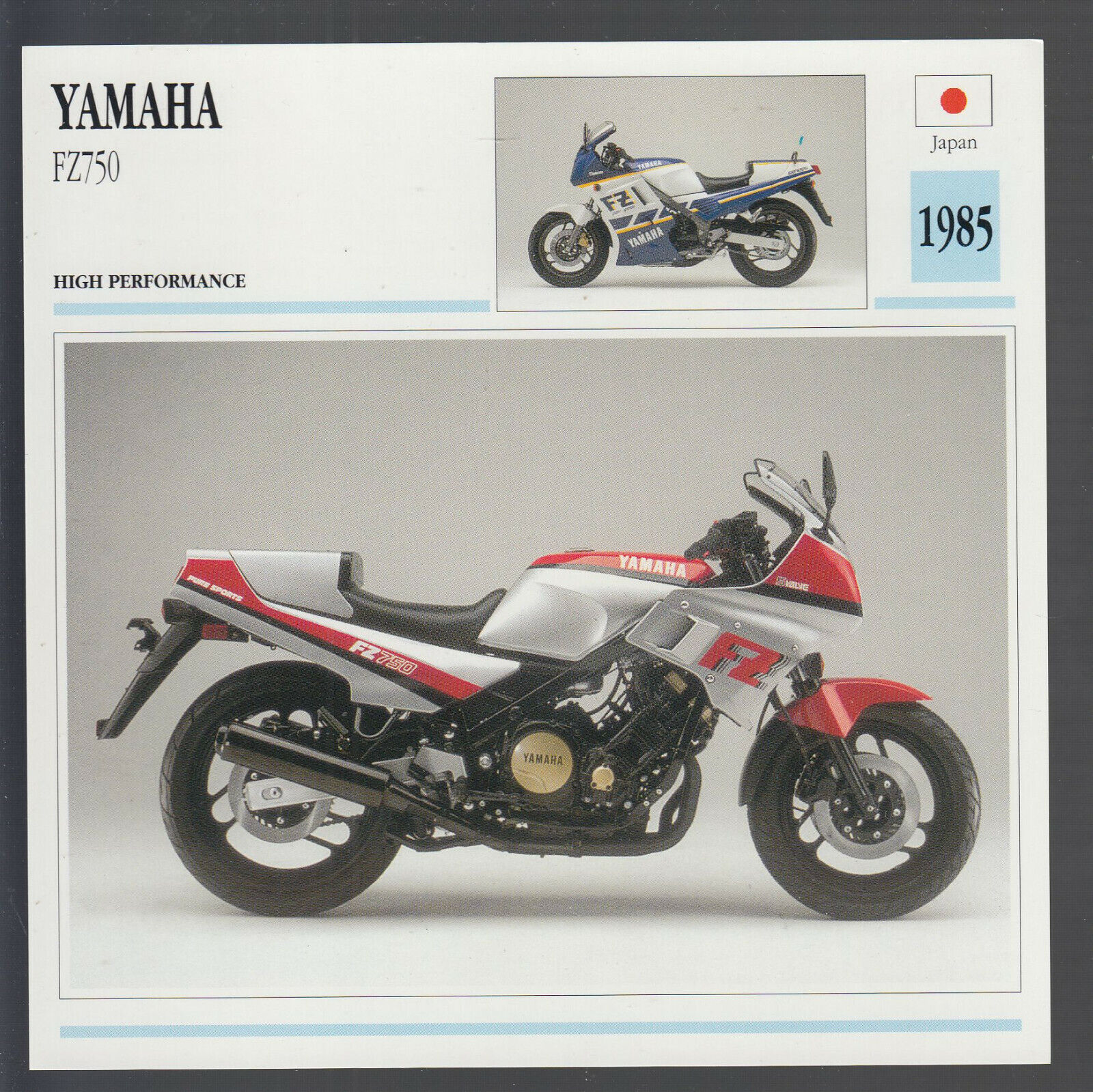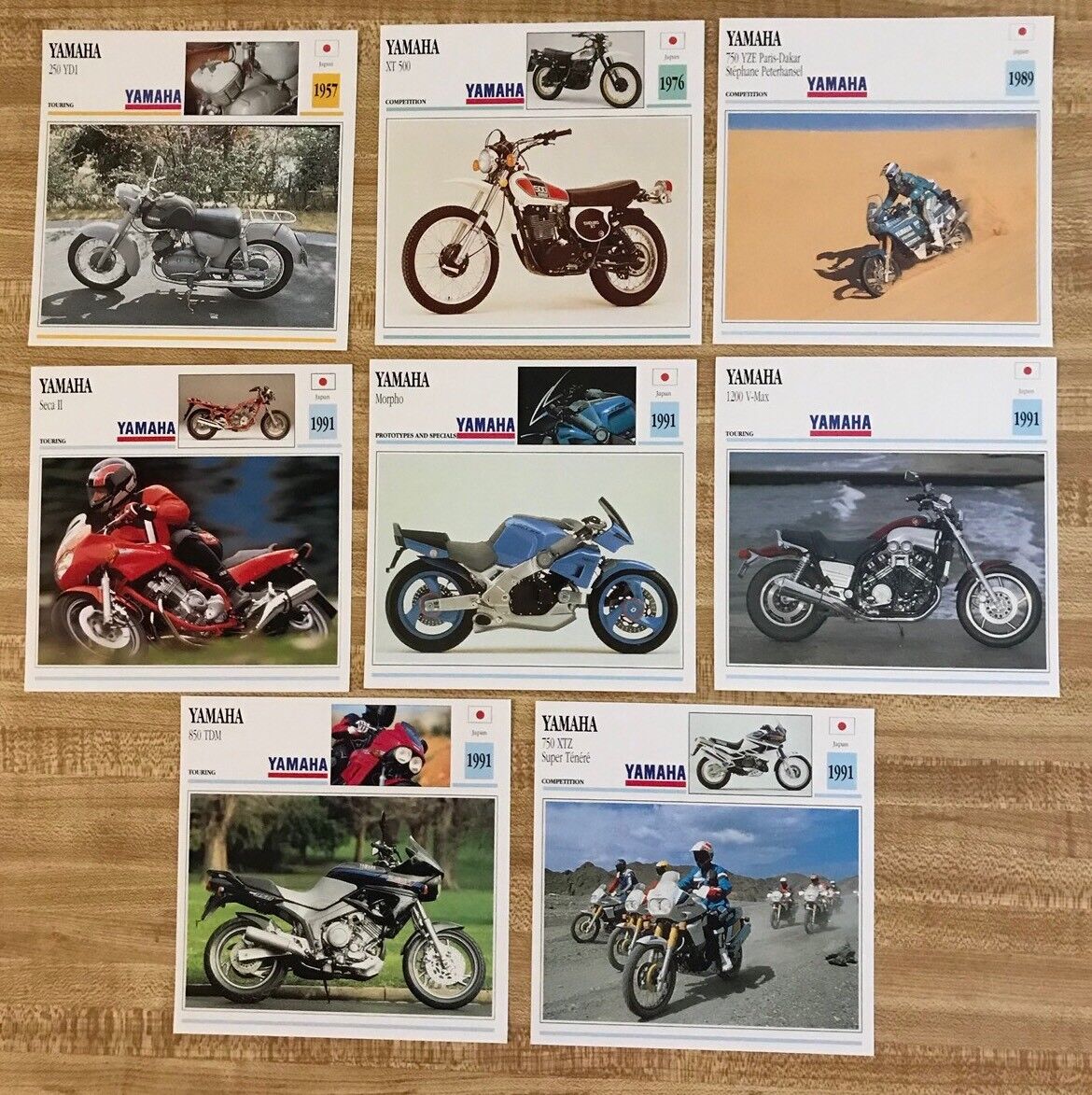-40%
1975 Yamaha RD350B - 7-Page Vintage Motorcycle Road Test Article
$ 7.3
- Description
- Size Guide
Description
1975 Yamaha RD350B - 7-Page Vintage Motorcycle Road Test ArticleOriginal, vintage magazine article.
Page Size: Approx. 8" x 11" (21 cm x 28 cm) each page
Condition: Good
CYCLE GUIDE ROAD TEST
YAMAHA RD 350B
A mini-superbike, a medium-range tourer, and a
rapid-transit commuter ail rolled into one
A lot of street riders have decided to
live in the 350cc class. The reasons arc
fairly obvious. Most modern 350 street
bikes are powerful enough io run all day
at illegal speeds, light enough to cooperate
when being muscled into a parking place,
small enough to suggest gas economy, and
big enough to behave like real motorcy-
cles. And probably most important is that
350s come with smaller-displacement
price tags than bigger machines, which is
something which matters more all the
time.
Honda has sold more 350s than most
motorcycle manufacturers have sold mo-
torcycles, which is just one indication of
how popular 350s are. The Honda 350's
success has made the other manufacturers
envious, and the struggle for the 350
buyer's dollar has gotten fairly competi-
tive in recent years. Suzuki popped out
a 380cc triple, and Kawasaki punched
their 350 two-stroke out to 400cc. then
added a 400cc four-stroke to their line.
Honda reworked their 350 (actually 325cc)
twin and made it a 360. and their 350cc
four became a 400.
Right in the middle of the Great 350
War stood Yamaha, the world's second
largest manufacturer of motorcycles. With
all their vast resources they weren’t going
to be outdone in the 350 class. No sir.
For 1975 Yamaha responded by . . . re-
painting last year’s bike.
You wouldn’t think a paint job would
be a sufficient counterattack to the bigger
bores and multi cylinders of the opposi-
tion. but take a closer look. In perfor-
mance Yamaha RD350s have ruled their
displacement class since 1970 when the
first one (called the R5 then) hit the
streets. In fact, they have been downright
embarrassments to some 500s and 750s.
The RD350 bears more than a superficial
resemblance to its road racing relatives in
the 250 and 350 classes—classes which
Yamaha has ruled almost without chal-
lenge for the past decade. The RD350 has
also absolutely dominated 350 production
road racing. And on the streets and free-
ways of America the 350 has earned a
reputation for being a first-class com-
muter. a potent stop-light racer, and an
uncatchable mountain road-runner. So
perhaps Yamaha’s approach to the com-
petitive 350 class was to not change horses
while they were ahead. Or could it be that
they are too confident and have dropped
the ball?
THE BIKE: The twin-cylinder two-
stroke RD35OB shares the same lower end,
transmission ratios, clutch, and carbure-
tors with its little brother, the RD250B.
Outside of the engine, the running gear
is virtually the same. The major difference
between the Yamaha RD350 and the
RD250 is cylinder bore dimension. The
250's bore/stroke dimensions are 54mm
by 54mm. but the 350 has an additional
10mm of bore per cylinder for a dis-
placement of 347.4cc. These dimensions
also correspond to those of the all-
conquering Yamaha road racers, making
the top ends of the 250 and 350 road racers
interchangeable with those of the 250 and
350 street bikes. The RD350 has a com-
pression ratio of 6.6:1.
Two 28mm Mikuni slide/needle carbu-
PHOTOGRAPHY BY ART FRIEDMAN
retors feed the 350, and only the left carb,
where the “choke” lever is mounted, has
a starting plunger. For cold starting, you
depress the lever, which raises the plunger
and allows a super-rich mixture to flow
directly into the venturi of the left carb
and also through a short hose into the
venturi of the right carb.
The fuel/air mixture enters each cylin-
der through a four-petal reed valve. Two
windows in the intake skirt of each piston
keep the intake port open to the crankcase
even when the lower edge of the piston
skirl has dropped below the port. The
one-way reed valve allows mixture to pass
into the crankcase, but any pressure on
the reeds from gases trying to escape snaps
the petals shut. In this way Yamaha feels
it can obtain maximum crankcase charg-
ing al all speeds; the intake port can be
left open to let in a lot of fuel mixture
at high engine speeds, but the low-speed
power doesn’t suffer.
To gel the mixture from the well-
charged crankcases to the combustion
chambers, five transfer ports are provided
in each cylinder. There are two main
transfers, one on each side of the cylinder,
and a smaller auxiliary transfer port be-
hind each main. In addition, there's a
boost passage cut into the cylinder wall
on the lop of the intake port. A single
exhaust port in each cylinder handles es-
caping exhaust gases.
Two sets of points for the batlery/coil
ignition system are driven off the left end
of the crankshaft, and the crank’s right
end delivers power to a wet clutch through
helical-cut primary gears. The six-speed
transmission shifts on the left with a con-
ventional pattern —up on the lever for a
higher gear, with neutral between first and
second.
The engine is lubricated by Yamaha's
Autolube injection system. An oil pump
driven oil the right end of the crankshaft
pumps oil to the carburetor throats to mix
with the inrushing mixture going to the
engine. The quantity of oil delivered is
determined by the amount of throttle
opening and engine speed.
The double-loop cradle frame very
closely follows the lines of the frames
found on the Yamaha road racers. The
engine is carried relatively far rearward
of the front wheel, which supports only
42.4% of the bike’s dry weight. In percent-
ages that is about as little as any street
bike ever measured by Cycle Guide.
Eighteen-inch Dunlops are mounted on
both ends of the bike, a 3.00 x 18 rib at
the front and a 3.50 x 18 K95 tread at
the rear. The front brake is a double-ac-
tion (fixed caliper) hydraulic disc. Each
puck is equipped with a wear indicator
lab that tells you it is lime to replace the
puck when the tab gels within half a mil-
limeter of the brake disc. The rear brake
is a single-leading shoe type operated by
a rod linkage. A hole in the backing plate
covered by a rubber plug allows you to
check the brake lining thickness.
The steel gas tank holds 3.2 gallons and
has a locking cap. The hinged dual seat
also locks and swings up to provide quick
and easy access to the paper air filler
element and 12-volt battery. The tool kit
slides under the rear of the tank and is
also reached by raising the seat. There is
a compartment on the underside of the
seat for registration papers and the very
complete owner’s manual. Also under the
seal is the filler hole for the 2.1-quart oil
injection lank mounted on the left side
of the frame. By placing the filler under
the seat. Yamaha has made it difficult to
use without a funnel, but has kept it out
of the reach of vandals. There is also a
dipstick and a window for checking the
oil level.
In addition to an accurate, easy-lo-read
120-mph speedometer and 10.000-rpm
tachometer, the instrument panel contains
a neutral light, turn signal indicator lights
(one for each direction), a high beam
indicator light, and a brake light warning
light that comes on when either brake is
applied and blinks if the brake light fila-
ment burns out or is disconnected. There
is nothing to warn you if the running light
filament of the taillight burns out. how-
ever. The ignition switch is in the middle
of the instrument panel and will accept
the key regardless of which way you insert
it.
The handlebar switches are laid out
conventionally, with the light and kill
switches on the right handlebar, and the
dimmer, turn signal, and horn switches on
the left. Like many components on the
bike., the switches are flat black. The en-
gine is nicely styled and painted fiat black
and the edges of the cylinder fins are
highly polished. The side panels and gas
tank are painted bright orange with black
and while accents. The exterior finish and
all the visible welds on our lest bike were
very clean and neat.
The whole package weighs 327 pounds
with the gas tank empty and costs SI211
(24 East Coast). The price tag has
climbed almost 0 since last year, but
it still compares favorably with the Honda
CB400 Four we tested in January (33).
the Suzuki GT-380 (95), the Kawasaki
KZ400 (19). and the Kawasaki 400cc
S3 (SI 197).
ENGINE AND GEARBOX: It usually
look three kicks with the “choke” lever
depressed to start the RD35OB when it
was cold. When cold, the engine kicked
through stiffly and required a fairly vigor-
ous kick. If the engine was warm, it kicked
through with very little pressure and came
to life with only one kick. The kickstart
mechanism spins the engine through the
primary drive so the bike can be started
in gear if you puli the clutch lever in. The
right passenger peg occasionally got in the
way when we were kickstarting, even
if it was folded up.
When cold our RD350B required a
minute of warmup with the choke on. and
it ran roughly for the first three or four
minutes. During the wanning period, it
responded sluggishly and smoked more
than usual. It always smoked noticeably
al idle and when we ran it hard after
putting around below 4000 rpm for a
while. Once it got warmed up. the 350
idled evenly.
Getting the RD35O rolling smoothly
from a dead stop requires a gradual clutch
engagement and a steady throttle hand
because the engine revs up so quickly.
Easing the clutch out at 2500-3000 rpm
will get you away calmly with no jerking,
wheelies, or engine bogging.
The engine has a very wide range of
usable power. The reed valve intake sys-
tem (which Yamaha calls “Torque Indue-
lion”) allows the engine to run sedately
al low rpm, but the porting is radical
enough to give outstanding top-end
horsepower. You can ride along in sixth
gear at just under 2000 rpm. then crank
the throttle grip to the stop, and the bike
will accelerate without a bit of hesitation.
It gains speed slowly at first but the accel-
eration increases more and more as the
revs build. The engine pulls very strongly
until almost 90 mph. and only then does
it begin to level off. finally reaching its
100 mph terminal speed. The engine is
redlined at 8500 rpm. but the tach will
occasionally see red in sixth.
The bike was difficult to get off the line
at the dragstrip because it’s so eager to
wheelie. You have to get your weight well
forward and slip the clutch unless you're
on a slippery piece of road, in which case
you can get the rear wheel spinning with-
out a wheelie. Once you master the tech-
nique—it will take a lot of learning—you'll
find the 340-pound bike charges oft' the
line very, very hard. The RD35O's off-
the-mark acceleration comes partially
from its low weight, partially from its low
first gear ratio, and partially from its
plentiful power. You have to grab second
as quickly as vou can get your foot to the
lever, and the rest of the gears come and
go in quick succession when you're twist-
ing the throttle hard. In stoplight-to-
stoplighl contests the Yamaha will stomp
any 350 Streeter made and most 500s. It
was just slightly slower at the dragstrip
than the Kawasaki 400cc S3 two-stroke
triple we tested last year, but quicker than...
15945

